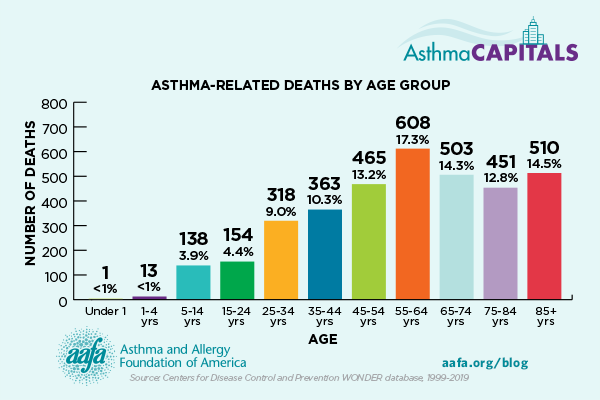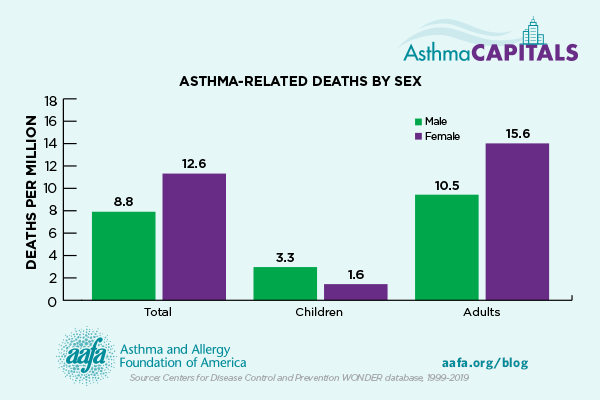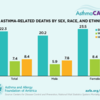The Asthma and Allergy Foundation of America’s 2021 Asthma Capitals™ report ranks the largest 100 U.S. metropolitan cities by how challenging they are to live in with asthma.
AAFA publishes this report to help people who live in Asthma Capitals advocate for better care and policies. The report also shows how communities can best direct their focus to reduce the impact of asthma.
In our report, we looked at three weighted outcomes to determine rankings: asthma prevalence, asthma-related emergency department visits, and asthma-related deaths. In this spotlight, we examine asthma-related deaths and what can be done to reduce a person’s risk of dying from asthma.
Many people don’t realize asthma can be fatal. But in 2019, 3,524 people lost their lives to asthma.1 That’s about 10 people per day. In our 2021 Asthma Capitals™ report, one factor that affected a city’s placement on the list was its number of asthma-related deaths (mortality).
This number has not changed much in the last 10 years. The top cities in our Asthma Capitals list must take action to prevent more of these tragedies.
According to our 2021 Asthma Capitals™ report, the cities with the most asthma-related deaths are:
- Baltimore, Maryland
- Jackson, Mississippi
- Richmond, Virginia
- Cleveland, Ohio
- Tucson, Arizona
- New York, New York
- Memphis, Tennessee
- Detroit, Michigan
- Fresno, California
- Boston, Massachusetts
Some populations are at higher risk for dying from asthma than others. The causes of higher asthma death rates are complex but must be addressed to save lives.
Asthma-Related Disparities
Health disparities are preventable health differences between groups of people. These differences are linked to social, economic, and environmental disadvantages.
Disparities in asthma affect the number of asthma deaths in certain groups of people. Older adults, female adults, male children, and Black Americans have higher rates of asthma deaths.
Older adults tend to have higher asthma death rates. They are more likely to be underdiagnosed and undertreated. They are also more likely to have other health conditions that can make it harder to diagnose and treat asthma. As people age, their risk of dying from asthma increases.2

Overall, females are more likely to die from asthma. But when we look at age, more male children die from asthma than female children. In adults, adult females are at a much higher risk of dying from asthma than males.2

AAFA’s Asthma Disparities in America report looks at the burden of asthma on racial and ethnic groups in the United States.
Black Americans have the highest deaths due to asthma.3 Black people are about three times more likely to die from asthma than Hispanic or white individuals. And Black females have the highest rate of asthma deaths. This rate is nearly four times the asthma-related death rate among white males.

Reducing Asthma-Related Deaths
Most asthma deaths are preventable.
If you have asthma, to reduce your risk you can:
- Have access to asthma medicines and take them as prescribed
- Get medical care if you have symptoms more than twice per week
- Avoid or reduce your exposure to asthma triggers
- Learn the signs and symptoms of asthma, including early warning signs
- Have an Asthma Action Plan and take quick action according to the plan
Also, we can all work together to reduce the risk of asthma deaths in our local communities. Our 2021 Asthma Capitals™ report outlines ways law makers, local and federal officials, health care providers, and people with asthma and their caregivers can take to help improve asthma outcomes locally. Read the 2021 Asthma Capitals™ report to learn more.
The 2021 Asthma Capitals™ report is an independent research project of the Asthma and Allergy Foundation of America in part by support from the Pharmaceutical Care Management Association (PCMA) Foundation.
References
1. Centers for Disease Control and Prevention. Most recent national asthma data: Asthma mortality (2019). U.S. Department of Health and Human Services. https://www.cdc.gov/asthma/mos...onal_asthma_data.htm
2. Centers for Disease Control and Prevention WONDER database. (2020). Underlying cause of death, 1999-2019. U.S. Department of Health and Human Services. https://wonder.cdc.gov/ucd-icd10.html
3. Centers for Disease Control and Prevention, National Center for Health Statistics, National Vital Statistics System: Mortality (2018)
How Can I Learn More About the Report?
AAFA publishes the Asthma Capitals™ report to raise awareness about the nationwide impacts of asthma. The report analyzes data from across the continental United States and ranks the 100 largest cities by how challenging they are to live with asthma.
Visit asthmacapitals.com to see the full list and to learn more about asthma management and risk factors.
Join our online community where you can get support for asthma and allergies and stay up to date on news and research.




Comments (0)